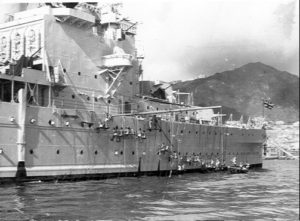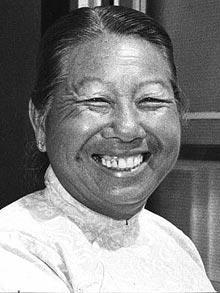Working in unprepossessing paint-stained overalls and traditional conical hats Chinese female contractors serviced British Commonwealth and US ships anchored off Hong Kong. A South China Morning Post outlined the civilian women’s formal role when ships arrived. These ‘side parties were groups of women who would clean the vessels, chip off rust and repaint their sides, wash and iron laundry, and take on other ship husbandry tasks.’[1]
In that ‘White Ensign – Red Dragon’ [2] Crown Colony, a kind of mini Devonport-Upon-Pacific, as many of 70 of these othered local women cheerfully took over visiting sailor’s domestic tasks, from the 1920s. This informal sub-contract work was discontinued after 80 years, when ships’ visits lessened and after the UK ‘handed back’ Hong Kong to become a Special Administrative Region of China in 1997.
Why are side party women of interest to maritime, gender, transpacific and emotion historians today? Because of the extraordinarily emotional nature of the recent web-based posthumous tributes paid by Western sailors to these waterfront labour teams.
Memorialisations
The enthusiastic – and necessarily partial – memorialisations especially focus on leaders of the two main side parties: Mrs Ng Muk-kah (1917-2009), sometimes known as ‘Gash Jenny’ because she worked with rubbish (‘gash’) and ‘Garbage Queen’ Mary Soo, (born c 1923).[3] These ‘harbourside angels’ are iconised in heterotopic 21C naval nostalgia chatrooms.[4] For example, the Grey Funnel Line Facebook post about ‘Jenny’ scored 93 likes, 19 comments and 25 shares.[5] ‘Motherly’ white women Perla Gibson (The Lady in White) and Dame Agnes Weston had similar iconic status among naval men.[6]
It is ‘Jenny’ who is the focus of this brief article:’ the ‘small round figure in traditional baggy black trousers and high-collared smock, with a long pigtail and eternal smile.’[7] Her nexus was with UK ships; a longer article will later compare her to Mary Soo’s links with US vessels.
Four key points are made about this Eastern businesswoman. She was:
- revered as ‘an institution’, ‘a legend to generations of sailors.’[8] She was awarded a British Empire Medal and positioned as a VIP in official photographs
- admired for the astonishing effectiveness, speed and high quality of ‘her girls’’ work.
- seen as enduringly available and ‘the same.’ ‘Regardless of time [she] remained, it seemed, for ever “just Jenny.”[9]
- liked for her ‘perpetual great gold-toothed grin’; ‘always smiling’ and friendly, she ‘looked after us’ and joked. ‘Rum Rat’ wrote: ‘I loved the old bugger; you could really have the crack with her.’[10]
‘Love’ actually
This last point is my focus here: ‘Jenny’ ‘with her white smock top, grey bun, and spectacles, was appreciated as warm and funny, as well as bossy. She created an enjoyable familial emotional rapport with young white sailors who were missing their families; she even touched them. Mike Chantler said: ‘I was on the Sheffield in 92-ish. She was always at the bottom of the gangway on berthing saying “Where’s the buffer?”’ (The buffer is the common name for Chief Boatswain’s Mate; that was Mike.) He added the key words: ‘We then proceeded to walk the length of the ship arm in arm identifying the work required.’
Another buffer, ‘Geoff Geoff’, speaks with fondness, but awareness of who held the power: ‘’I loved her when we went into Hong Kong; I always knew we would leave with the ship in a perfect condition. Mind you she could talk you out of anything if she fancied it, I have many a fond memory of Jenny and her girls.’[11] Others acknowledged that she was ‘steely ‘and ‘astute’ too.
How are we to see Mrs Ng Muk-kah and her nexus? Anthropologist Valene Smith usefully highlights that the complex power relations of hosts and guests in tourism is seldom clear cut.[12] ‘Jenny’ was not simply the local host of these ‘enforced tourists’; she also climbed onto their territory as an honoured ‘guest’ who made herself at home. Sociologist Marcel Mauss’s theories of the ’gift relationship’ help us speculate about the tactical skills and power relations of a women who insisted on only being paid in rubbish, and who ‘paid’ for her contracts by giving these visiting guests free newspapers and flowers and remembering their birthdays.[13]
Not sex but reverence
Normal brief colonial encounters, for example with sex workers, seldom produced positive affective attachment as strong as those with an idealised grandmother or strict-but- indulgent nanny, despite her being from the wrong side of the Pacific.[14]
White naval Westerners in an institution that required inmates to be hyper-masculine might see side party women as lesser figures: they were discursively contaminated by handling primitive dirt. All civilian women were matter out of place on war-focused ships. Side party women were disadvantaged because of gender, age, size, and all that their stigmatised colour stood for. Some were from Hong Kong’s denigrated and literally marginal boat people community; ‘Jenny’ was said to have been ‘born in a sampan.’[15] Unlike visiting sailors, side party women were self-employed on ad hoc basis.
And yet she is internationally revered. Why? It cannot be simply a matter of ‘Well, they would say that, wouldn’t they?’ following the tone of the obituaries in 2009. Maybe the tone is partly a consequence of visitor-memorialisers applying rosy and under-nuanced spectacles because they are at a particular later-life course stage. But possibly the glowing terms are a reflection of something genuinely impressive: a satisfyingly humane encounter with a person of Orient.
There is a necessary next step to counter-balance the fragments posted by white naval male veterans writing for public consumption. Hong Kong scholars will hopefully go on uncover the women’s own voices as knowledgeable subjects and clever agents. Mrs Ng Muk-kah is deceased; Mary Soo might be too. But surely there remain some side party women who can give a more nuanced account of what is undoubtedly the most emotional story of waterside gendered labour to ever be recorded.
Notes
[1] Annemarie Evans, “Jenny ran a shipshape side party,” South China Morning Post, 5 April 2009.
[2] P. J. Melson (ed.), White Ensign – Red Dragon; History of the Royal Navy in Hong Kong, 1841-1997, (Liskeard: Maritime Books, 1997).
[3] There were at least three other teams too, Mary Ah-Choy, Ah Moy, and Suzie. However their leaders have not been celebrated as ‘Jenny’ and Mary Sue/Soo were.) NB. It was customary for several generations to use the same name, so ‘Jenny’ and ‘Mary’ may actually refer to a mother, daughter, and granddaughter and be almost metonymic. Certainly there was a ‘Jenny One’ who began sub-contracting in the 1920s.
[4] Chatrooms include (the UK’s) www.navy-net.co.uk and www.shipsnostalgia.com; (the US’s) Facebook sites for veterans of individual US ships, such as USS Slater, Yorktown and Wilson;(Australia’s) navyhistory.org.au. See also Grey Funnel Line on Facebook (https://tinyurl.com/Jenny-grey-Funnel); Flickr; and Gwulo: Old Hong Kong (https://gwulo.com/atom/28606), all last accessed 11 April 2020.
[5] Flickr (https://www.flickr.com/photos/41311545@N05/3817330394), last accessed 11 April 2020.
[6] Jonathan Hyslop, “The Lady in White: British Imperial Loyalism and Women’s Volunteerism in. Second World War Durban,” Journal of Natal and Zulu History, vol. 32, no 1, (2018) 38-54. Mary A. Conley, From Jack Tar to Union Jack: Representing naval manhood in the British Empire, 1870-1918, (Manchester: Manchester University Press, 2009), 66-98.
[7] The Jimmy, 23 March 2009, https://tinyurl.com/Jenny-navy-net, last accessed 11 April 2020.
[8] Obituary: ‘Jenny’, Daily Telegraph, 25 March 2009, https://tinyurl.com/D-Tel-Jenny. For those seeking a full obituary not confined by a pay wall see https://tinyurl.com/Jenny-navy-net. The obituary there appears to be lifted from the Telegraph.
[9] The Jimmy, 23 March 2009.
[10] Rum Rat, Navy Net, 8 April 2009, https://tinyurl.com/Jenny-navy-net, last accessed 11 April 2020.
[11] Mike Chantler, and Geoff Geoff, https://tinyurl.com/Jenny-grey-Funnel, last accessed 11 April 2020.
[12] Valene L. Smith, Hosts and Guests, the anthropology of Tourism, (Philadelphia: University of Pennsylvania Press, 1989).
[13] Marcel Mauss, The Gift: forms and functions of exchange in archaic societies, (London: Routledge, 1992).
[14] Lily Wong, Transpacific Attachments: Sex Work, Media Networks, and Affective Histories of Chineseness, (New York: Columbia University Press, 2020).
[15] Telegraph obituary, 25 March 2009.












Comments are closed.